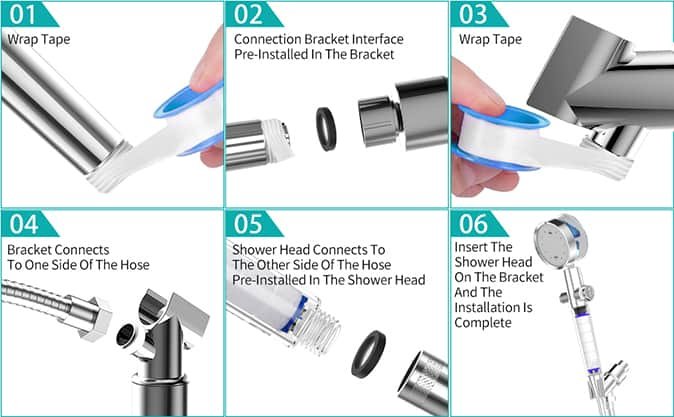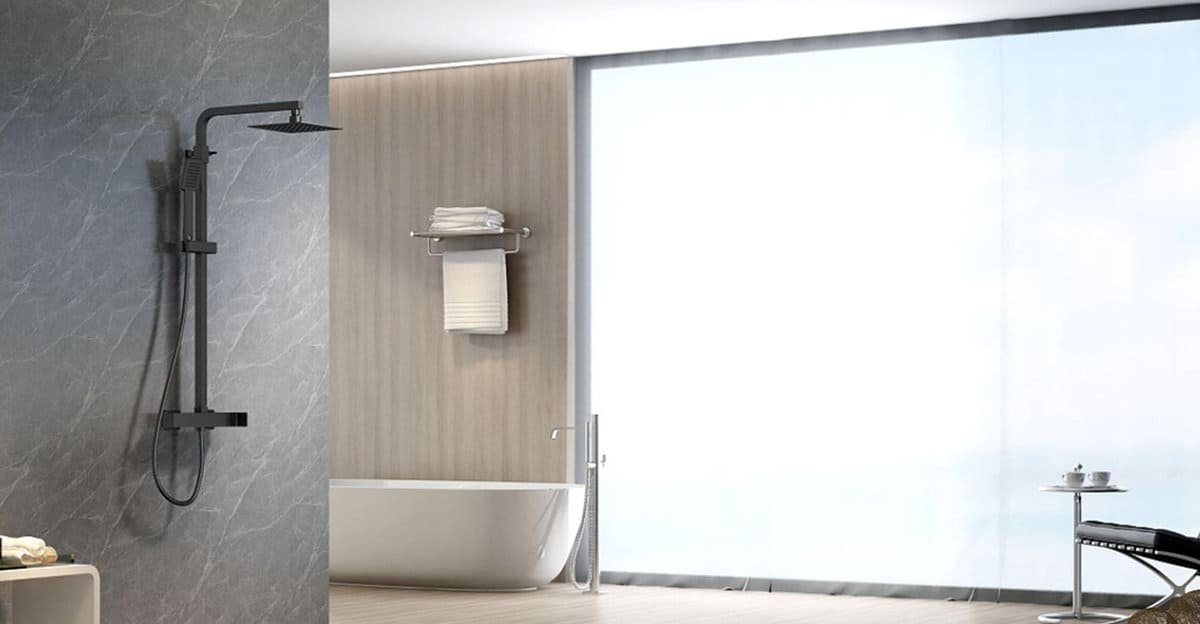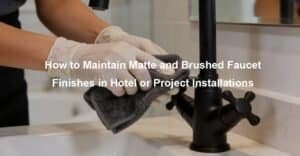Install a Shower Faucet
Shower faucets are an essential part of anyone’s shower fixtures. It’s something that can make your shower experience more pleasurable and comfortable. shower faucets are an important part of your shower, so make sure you know how to install one properly.
What are Shower Faucets?
A shower faucet is a device that is used to control the flow of water in a bathtub or shower. It is important to choose the right shower faucet for your bathroom. The best way to do this is to think about what you will be using the shower faucet for. If you are going to be using the shower faucet for something other than a bathtub or shower, then you should choose a faucet that is appropriate for that purpose.
For example, if you are going to use the shower faucet for a sink, then you need to choose a mixer that is appropriate for use in a sink. If you are going to be using the shower faucet for a bathtub or shower, then you need to decide if you want a faucet with a single handle or a faucet with two handles. You should also decide if you want a faucet with a lever or a faucet with a handle that you pull up.
How Does The Shower Head Work?
A shower mixer is a plumbing fixture, usually found in a bathroom, that allows water to flow from a showerhead. It is a type of valve that is used to regulate the amount of water that flows from the showerhead. The showerhead is connected to the shower mixer by a spout that is screwed into the showerhead. The shower mixer consists of a handle and a spout. Handle controls the flow of water on and off.

The spout is where the water comes out. The handle of the shower mixer is usually connected to a shower arm. The shower arm is usually made of plastic and is connected to the spout. There are many different types of shower faucets, such as high arc, low arc, and arc with high pressure. A shower faucet is usually found in a bathroom, but it can also be found in a kitchen.
What Kinds of Shower Heads are There?
A shower mixer is a shower head that is connected to a shower arm. There are many different types of showerheads, each with its unique benefits. The first type of shower head is the fixed shower head. This type of shower head is not adjustable and doesn’t have a swivel joint. The next type of showerhead is the fixed-arm showerhead. This type of shower head has a fixed arm that is attached to a shower arm.
This showerhead is great for people with limited mobility. The next type of showerhead is the swivel-arm showerhead. This type of shower head is great for people who have limited mobility because the shower arm is attached to a swivel joint. The last type of showerhead is the frameless showerhead. This type of showerhead doesn’t have a shower arm. This showerhead is great for people who want a frameless showerhead.
Material of shower head
Plastic shower head: plastic material, the water outlet hole is silicone. Stainless steel shower nozzle: stainless steel shower nozzle is resistant to wear and tear, rust-free, and affordable. Aluminum alloy, aluminum-magnesium alloy material shower nozzle: aluminum alloy, aluminum-magnesium alloy advantage is not afraid of wear and tear, lightweight and durable. Copper plating complex material shower nozzle: hollow copper shower advantages of style; all copper shower fine workmanship, the plating layer is thicker, strong and durable.
How to Install the Shower Faucet?
The first step in installing a shower mixer is to determine the type of shower that you are installing. There are a few different types of shower faucets, and each has its unique way of installation. The type of shower mixer that you install is not just a matter of personal preference.

The type of shower mixer that you install will depend on the type of fixture you are installing. If you are installing a single hole, you will need to use a single-hole faucet. If you are installing a double hole, you will need a double-hole faucet. If you are installing a single-hole faucet that is attached to a hose bib, you will need a single-hole faucet with a hose bib. Here are the detailed steps.
Assemble the other necessary tools and equipment
Aside from the replacement parts or the new faucet, the following tools and materials are needed to complete this project:
Adjustable pliers
A large adjustable wrench or pipe wrench
Teflon tape (often called plumber’s tape)
Screwdrivers (Phillips and flat head)
A pan or container to catch any water remaining in pipes
Towels or rags for wiping up small puddles and drips
A box or container for discarded components
Safety goggles and gloves
Turn off your main water supply
Locate the shut-off old valve for the appropriate bathroom and turn off the water. Most homes have shut-offs in place for individual bathrooms as well as one for the kitchen so you should not need to shut off the water supply for the whole house.
If you are on a city water system, the shut-off valve should be located at the water meter. If your home is on a private well, you will need to find your pressure tank. Newer tanks are usually blue, while older tanks may be any color.
Typically, the shut-off old valve itself is located on the main outlet pipe near the tank. To close this valve at either source, turn it clockwise until closed. This will immediately stop water flow to the house. Once you have shut off the water supply, open the shower mixer valves to release the remaining water from the pipes and ensure that the water is indeed off.
Cover the floor of your tub or shower with canvas
If you’re going to be cutting through the tiles or wall, it’s important to drop some cloth to protect the bathtub. Make sure the shower area is clean and dry, then use a painter’s drop cloth or other protective covering on the shower floor and tub surface to protect it from scratches and chips. After securing your lovely home, you can get on installing a shower head faucet.
Remove the handles
Use a flat-headed screwdriver to pry up the small caps on each of the handles. These caps are usually marked with a “C” or “H”. Under the cap will be a screw to release the handles.
Remove the retaining screws then remove the handles by pulling them off the valve stems. If the screws are rusted, it may take a little extra effort to loosen the screws. If necessary, use penetrating oil to help break through the rust.
Remove the spout
To remove the old spout, twist counterclockwise gently and pull towards you at the same time. There may be a small screw that will require removal before you can take it off. You may find that pliers or a pipe wrench are helpful when removing old fixtures. Use what tools work best for you.
On some faucets, the diverter handle will have an arrow on it. Use a flat-head screwdriver or a butter knife or something similar to pry the cap from the handle to reveal the retaining screw. Before removing the retaining screw, you’ll need to open the valve completely by turning the handle counterclockwise. This keeps the valve from turning while removing the screw.
Remove the flange
On most two-handle and three-handle faucets, there are chrome flanges about three inches long. Firmly grasp the flange and remove it by turning it counterclockwise. There is a white nylon threaded sleeve that may not come off as you remove the flange. If this happens, simply grasp the sleeve with your hand or a pair of pliers and turn it counterclockwise to remove it.
Single-handled faucets have a large round plate that is attached either with caulking or with screws. After removing the handle, remove the plate by removing the screws or by cutting the caulking with a utility knife. Then pull the plate from the wall.
Remove the valve assemblies
These should have a hex-shaped base near the wall and you can use an adjustable wrench or adjustable pliers to remove them. Turn them counterclockwise until they come loose. Once removed, use a damp cloth or an old toothbrush to remove debris from the threads of the water inlet pipes.
Mark where the new heads will go and make cuts if necessary
If you install the shower, you need to measure and mark the spots where you will install the shower faucet and a shower head. Shower faucets are typically installed at a height of 45 to 48 inches (114.3 to 121.9 cm) and shower head height of 72 to 78 inches (1.83 to 1.98 m).
After making your measurements, drill holes using tile drill bits of the appropriate size, depending on the size of your shower components, and remove enough of the wall to access the pipe for proper installation.
After making cuts, clean the shower walls with bleach water or white vinegar water. Do not mix bleach and vinegar, as it can release noxious gas. Do not allow water to drip behind the wall. If it does, dry thoroughly before installing the new fixtures.
Open and check the valve assemblies before installation
Take all of the new valve assemblies and open them fully before installing them. Do this by turning the stems counterclockwise. Each valve needs to be opened when it’s installed to allow it to seat fully on the pipe components. Be sure to identify the diverter valve and set it aside to install it last. The diverter valve is very important.
The process of installing a new faucet will be essential to the reverse process of your disassembly. If you purchased an identical or similar kit to the version you removed, it should be quite easy.
Tape the new valves
Take the role of plumber’s tape and peel the end back a couple of inches. With the new valve in one hand, hold the threaded base pointing to your other hand. Place the loose end of the plumber’s tape over the threads and secure it with your thumb, then wrap tightly around the threads clockwise for three complete wraps.
Pull tightly against the threads until the tape breaks. Roll the loose end over the tapped threads. If done correctly, the tape will contour to the threads. It’s recommended that you use Teflon tape for tight and leak-proof connections. However, some faucet setups don’t require the use of Teflon tape, which is why it’s recommended that you consult the manufacturer’s instructions.
Repeat this process for all the new valve components. Taping the valves allows a tighter seal to be created, ensuring a solid mixer that won’t leak.
Install the new valves
Place the new valve into the pipe and turn clockwise with your fingers for about three or four complete turns. There should be some resistance after that because of the plumber’s tape.
If the valve does not seat in the threaded pipe within the first turn or two, start again. Do not force an improperly seated valve. It will strip the threads and cause a serious leak. Repeat this step for all valves.
Completely tighten the valves with adjustable pliers or an adjustable wrench. Do not over-tighten or you risk damaging the valve or the water pipes.

Install the sleeve
Take the threaded white nylon sleeve, slip it over each valve stem, and twist it into the threaded interior of the valve base. Do not use pliers or a pipe wrench, as this will damage the threads. Wrap a cloth rag around the sleeve and grip it tightly with your hand and twist it into place.
Install the flange
Take the chrome flange and twist it onto the nylon sleeve until the base of the flange is snug against the shower wall. Place the new faucet handle over the notched tip of the valve stem. Hold the handle firmly and insert and tighten the retaining screw. Do not over-tighten to avoid stripping the threads. Turn the handle clockwise to close the valve and place the handle in the shut-off position. Repeat these steps for each of the valves.
Install the retaining screw cover on each handle
Insert the covers so “H” is on the left side, “C” is on the right side, and the arrow on the diverter cap is pointing down.
Use bathtub caulk to seal any gaps where hardware meets the shower wall
Caulk the fixtures where they touch the walls using silicone caulk, and allow them to dry. In general, you shouldn’t use a freshly caulked shower for at least 24 hours.
Turn the water supply back on and check for leaks
Turn on your water supply and check that everything works properly. Do not be surprised by some initial sputtering of the water when you test your shower faucets. The water pressure is simply forcing air out of the line. The sputtering should stop within a few seconds. If the water flow is normal, the installation is successful.
Shower head installation height
- The height of the shower mixing valve from the ground: when we install the shower, the first thing to determine is the height of the shower mixing valve from the ground, generally before installing the shower, we have determined the place where the shower is installed. Then the distance between the shower mixer valve and the ground, we generally control the height range of about 90~100cm. In this range, we can also be fine-tuned according to their height. But generally do not be higher than 110cm, too high then may lead to a shower lift tube can not be installed.

- The shower faucet reserved height: the general installation of the shower faucet reserved silk head just buried in the wall tile. With a decorative cover, just a cover is the best. Otherwise, it will not look very beautiful. So it is best to lay the pipeline when the location of the reservation is first considered clearly, generally 15mm higher than the rough wall, so that when the tile is finished just can be buried filament head to ensure that the wall is beautiful.
- The spacing of the elbow of the inner wire of the shower: the spacing of the elbow of the inner wire of the shower is generally standard at about 10-15cm. Generally, when you buy a shower, the seller will give two adapters, so that the mixing valve can be well connected to the hot and cold water outlet on the wall.
But as far as possible or not to use the adapter to adapter, so more beautiful some. Also, install a cross stud between the two studs at showerhead height to attach the drop-ear elbow. Apply polytetrafluoroethylene (PTFE) tape to the filets of the upper outlet of the drop-ear elbow. Connect the drop-ear elbow to the shower head supply tube. Screw the drop-ear elbow to the cross stud.
Shower head installation considerations
- After the installation of the faucet, must be horizontal not tilted, about 900-1100mm from the ground. use a wrench to install the faucet take care not to damage the plating surface.
- The shower installation in installation holes are punched into the expansion tube, with self-tapping screws to fix the wall seat to the wall. Note: the wall seat must be in the same center line as the faucet outlet connector.
- Shower installation drilling before the faucet with cloth 9 will be wrapped well to avoid the faucet being dirty and bruised.
- Shower installation height “H” need to be determined according to the actual product during the actual installation.
- After the shower installation, open the water inlet switch J to flush the pipe thoroughly.
How to Maintain Your Shower Faucet?
Single-handle mixer in the process of use, to slowly open and close, the double-handle mixer can not be closed too dead, otherwise, it will make the water stop bolt off, the cause can not close, can not stop the water.
Wall-mounted shower faucets are generally more prominent, so be careful not to bump or press them when you put things. Especially some brands of imported mixer surface plating treatment are quite thick, and can not afford to touch hard objects or grind, so they are in use, as far as possible to avoid contact with rings and other hard objects, so as not to cause fatal injuries.
In the case of water pressure is not less than 0.02 mpa, if you find that the water output is reduced, the mixer may be clogged inside. The solution is to use a wrench to gently unscrew the spout at the mixer spout screen cover, clean the impurities, and then carefully installed, generally can be restored as before.
How to Choose The Right Shower Faucet?

Color matching Shower faucets are mostly made of stainless steel. The color is modern and fashionable. Choose a shower room with the same stainless steel frame, bathroom racks, and other bathroom products of the same color to match, and wall tiles can also be used. Colors with strong visual effects, such as black, can enhance the modern sense of the bathroom and enhance the fashion.
Unit type matching The shower mixer is suitable for all types of apartment decoration. The simple shower room is matched with the shower head, occupying a corner of the bathroom, simple and fashionable. If the whole house is larger, you can choose double faucet handles and a water outlet, which looks atmospheric. For small apartments, you can choose a single handle faucet, which is small and exquisite, suitable for IKEA.
Consider the actual situation of the family. Shower faucets with two handles, such as hot water in the left hand and cold water in the right hand, are marked and easy to use and are more suitable for the elderly or children. Open the hot water supply, you can get hot water. Open the cold water supply, you can get cold water. The shape of the single handle is relatively beautiful, the shape is simple, and the hot and cold water can be adjusted by rotating left and right. It is easy to operate but needs to be used carefully to avoid burning.
You can also choose a thermostatic shower mixer, which is very convenient to use. Just adjust the water temperature or set the water temperature according to the temperature you need to shower. You can adjust the cold water or hot water at will. You do not need to adjust it as often as a normal shower, and it will not always be hot and cold water. You can set the temperature limit it’s the most important step is to set the temperature limit to prevent scalding.
How to Clean Your Shower Faucet?
The surface of the mixer should be gently wiped with a soft cloth (without impurities) dipped in detergent. Avoid using wire balls or scouring pads with hard particles. In addition, do not hit hard objects to bruise the surface of the mixer.
Use the following cleaners to remove rough masks and buildup: mild liquid glass cleaner, pure liquid glass cleaner, acid-free, non-abrasive soft liquid or powder that dissolves completely, and non-abrasive solution polish.

Never use any abrasive cleaners, cloths, or paper cloths; never use any acid-containing cleaners, polishing abrasives, or rough cleaners.
Under the condition that the water pressure is not lower than 0.02mpa (ie 0.2kgf/cm2), after a period of use, if it is found that the water output decreases or even the water heater are turned off, it can be lighted at the water outlet of the mixer. Gently unscrew the screen cover to remove impurities, and generally, it can be restored to its original state.
How to Fix a Leaking Shower Mixer?
Close the water valve
- The water valve may be installed in the bathroom or the basement.
- If you can’t find the water valve that controls the bathroom, you can also turn off the main valve in your home. The master valve should be in the forward position outside the house.
- Turn on the shower and make sure no water comes out.
Remove the handle
- This handle is the handle used to turn the shower on and off.
- Use a small folding knife to pry off the cover on the handle (located on the outside top of the handle). After prying it open, you can see the screws inside.
- Unscrew the screw with a screwdriver.
- If it doesn’t work, try heating it with a hair dryer. If you still have problems, go to the hardware store or home improvement store and buy a handle puller.
Remove the faucet valve core
- The large annular part against the wall is the valve core. It can be seen after removing the faucet handle.
- Use a spool puller. Available at hardware or home improvement stores.
Install new spool
Lorem ipsum dolor sit amet, consectetur adipiscing elit. Ut elit tellus, luctus nec ullamcorper mattis, pulvinar dapibus leo.
The handle must be screwed to the "closed" position
- If the shower mixer no longer leaks, the problem is solved.
- If the shower mixer is still leaking, go ahead and fix the mixer.
If the water valve is not closed, go and close it now
- The water valve may be installed in the bathroom or basement.
- If you can’t find the water valve that controls the bathroom, you can also turn off the main valve in your home. The master valve should be in the forward position outside the house.
- Turn on the shower and make sure no water is coming out.
Remove the mixer
- You will need a wrench or pliers.
- Drain any remaining water from the mixer.
Replace the rubber pads
- Rubber pads are inside the mixer.
- Go to a hardware store or home improvement store to buy new rubber mats.
- Make sure the rubber pads are just the right size and won’t shift when you attach the mixer.




